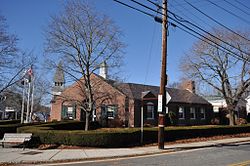History
Burrillville was settled around 1662 by English colonists [4] as part of Glocester, Rhode Island. [4] John Smith and members of the Saulsbury family were among the earliest settlers. Samuel Willard treated many smallpox victims in South Uxbridge and Glocester (Burrillville). [4] [5] In 1806, Burrillville became a separate town and consisted of 60 square miles (160 km2) of land in the northwestern corner of Rhode Island, bordering Connecticut and Massachusetts. [4] Boundary disputes with Massachusetts and Glocester reduced this land area by the mid-19th century. [4] Joktan Putnam was the first town moderator. [4]
The various mills and villages took shape in the 19th century, such as Harris mills and the village of Harrisville, Mapleville mills, and Oakland mills. [4] The town is today part of the Blackstone River Valley National Heritage Corridor, New England's historic National Park area. [6]
Burrillville was incorporated as an independent municipality on November 17, 1806, when the Rhode Island General Assembly authorized the residents of North Glocester to elect their own officers. The town was named for Senator James Burrill, Jr. who was the Rhode Island Attorney General. [7]
Demographics
Historical population| Census | Pop. | Note | %± |
|---|
| 1810 | 1,834 | | — |
|---|
| 1820 | 2,164 | | 18.0% |
|---|
| 1830 | 2,196 | | 1.5% |
|---|
| 1840 | 1,982 | | −9.7% |
|---|
| 1850 | 3,538 | | 78.5% |
|---|
| 1860 | 4,140 | | 17.0% |
|---|
| 1870 | 4,674 | | 12.9% |
|---|
| 1880 | 5,714 | | 22.3% |
|---|
| 1890 | 5,492 | | −3.9% |
|---|
| 1900 | 6,317 | | 15.0% |
|---|
| 1910 | 7,878 | | 24.7% |
|---|
| 1920 | 8,696 | | 10.4% |
|---|
| 1930 | 7,677 | | −11.7% |
|---|
| 1940 | 8,185 | | 6.6% |
|---|
| 1950 | 8,774 | | 7.2% |
|---|
| 1960 | 9,119 | | 3.9% |
|---|
| 1970 | 10,087 | | 10.6% |
|---|
| 1980 | 13,164 | | 30.5% |
|---|
| 1990 | 16,230 | | 23.3% |
|---|
| 2000 | 15,796 | | −2.7% |
|---|
| 2010 | 15,955 | | 1.0% |
|---|
| 2020 | 16,158 | | 1.3% |
|---|
|
As of the census of 2020, there were 16,158 people and 6,029 households in the town. The population density was 294.2 inhabitants per square mile (113.6/km2). There were 6,701 housing units in the town. The racial makeup of the town was 92.75% White, 0.65% African American, 0.15% Native American, 0.49% Asian, 0.05% Pacific Islander, 1.22% from other races, and 4.70% from two or more races. Hispanic or Latino of any race were 3.43% of the population.
There were 6,029 households, out of which 26.4% had children under the age of 18 living with them, 55.6% were married couples living together, 22.2% had a female householder with no spouse present, and 15.2% had a male householder with no spouse present. Of all households, 8.6% were made up of individuals, and 3.3% had someone living alone who was 65 years of age or older. The average household size was 2.63 and the average family size was 3.04.
In the town, the population was spread out, with 18.7% under the age of 18, 8.6% from 18 to 24, 23.2% from 25 to 44, 30.2% from 45 to 64, and 19.3% who were 65 years of age or older. The median age was 44 years.
The median income for a household in the town was $111,829, and the median income for a family was $129,363. The per capita income for the town was $46,197. About 6.9% of the population was below the poverty line, including 8.8% of those under age 18 and 6.1% of those age 65 or over.
Government
Burrillville town vote
by party in presidential elections [11] | Year | GOP | DEM | Others |
|---|
| 2020 | 57.46%4,906 | 40.22% 3,434 | 2.32% 198 |
| 2016 | 56.93%4,139 | 35.19% 2,558 | 7.88% 573 |
| 2012 | 44.19% 3,044 | 53.22%3,666 | 2.60% 179 |
| 2008 | 44.79% 3,160 | 52.87%3,730 | 2.34% 165 |
| 2004 | 47.61% 3,024 | 50.45%3,204 | 1.94% 123 |
| 2000 | 37.96% 2,228 | 54.70%3,211 | 7.34% 431 |
| 1996 | 26.25% 1,420 | 54.90%2,970 | 18.85% 1,020 |
| 1992 | 29.32% 1,880 | 38.27%2,454 | 32.41% 2,078 |
| 1988 | 47.85% 2,479 | 51.75%2,681 | 0.41% 21 |
In the Rhode Island Senate, Burrillville is a part of the 23rd District and is currently represented by Republican Jessica De La Cruz. At the federal level in the U.S. House of Representatives, Burrillville is in Rhode Island's 2nd congressional district, which is currently represented by Democrat Seth M. Magaziner.
In presidential elections, Burrillville has traditionally leaned Democratic; however, in 2016, Donald Trump became the first Republican to win the town in over three decades when he defeated former U.S. Secretary of State Hillary Clinton by approximately 22 points. This was the best Republican performance since 1920.
Burrillville was also one of seven towns in Rhode Island where independent candidate Ross Perot finished in second place during the 1992 presidential election. Perot received 2,018 votes (31.47 percent) behind Bill Clinton's 2,454 votes (38.27 percent) and ahead of George H. W. Bush's 1,880 (29.32 percent).
This page is based on this
Wikipedia article Text is available under the
CC BY-SA 4.0 license; additional terms may apply.
Images, videos and audio are available under their respective licenses.




